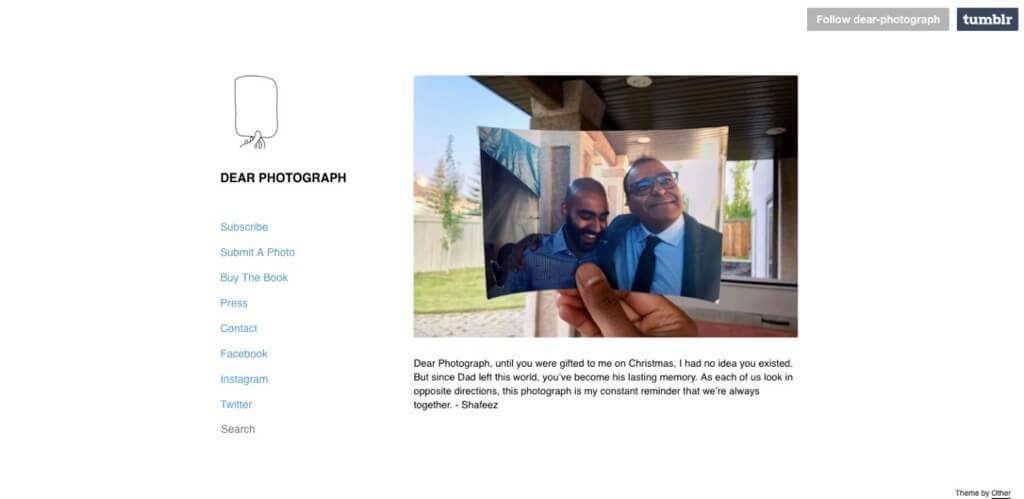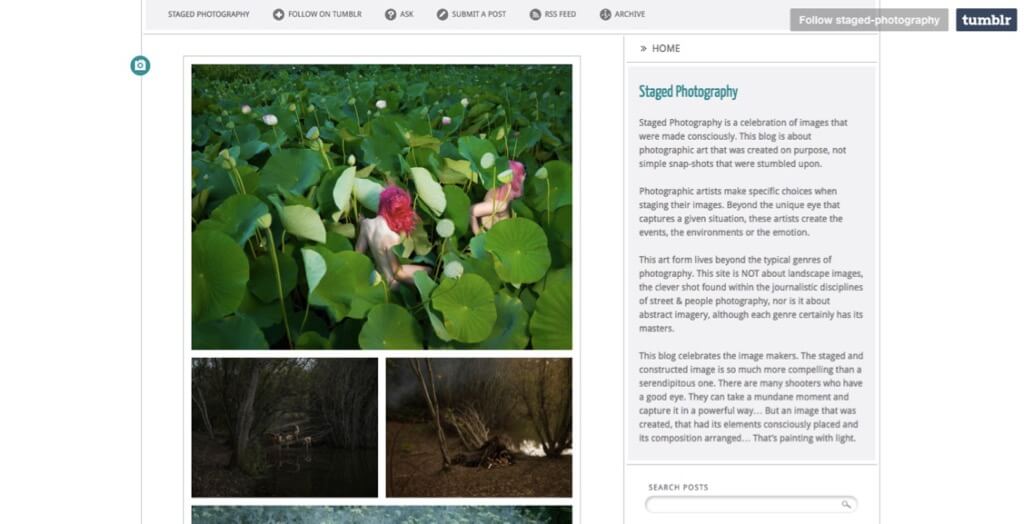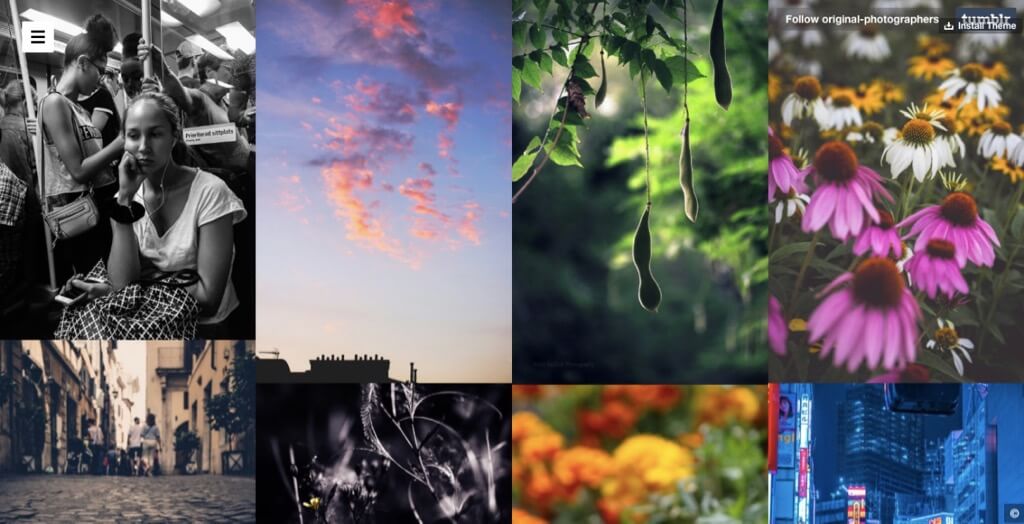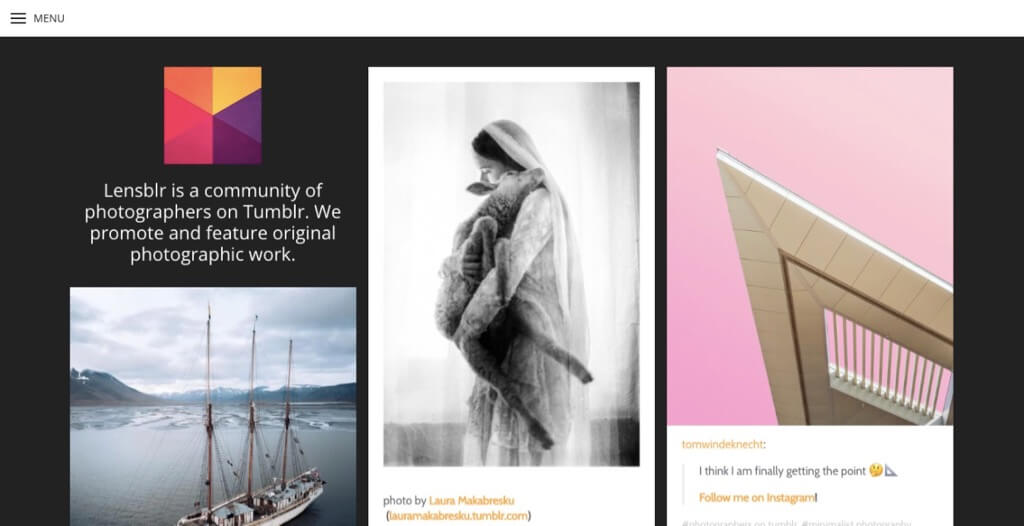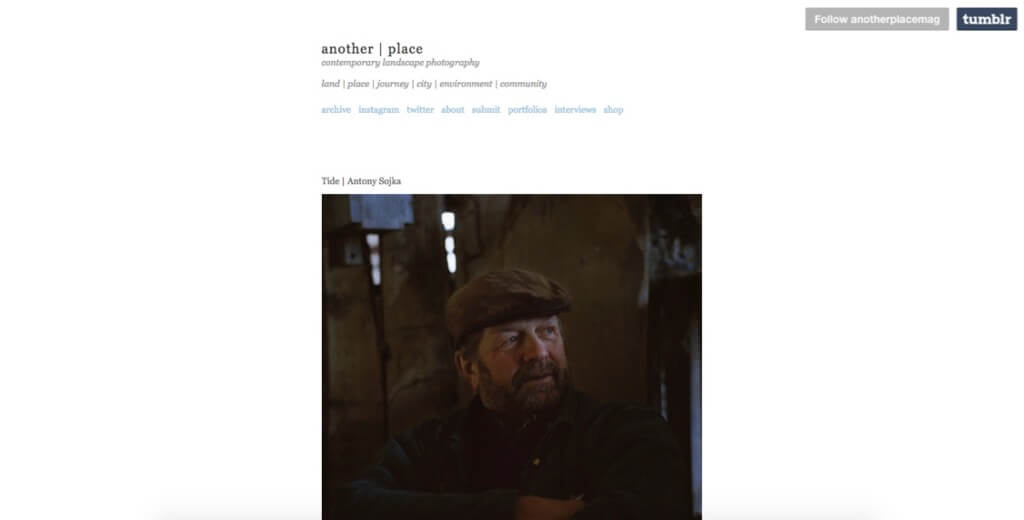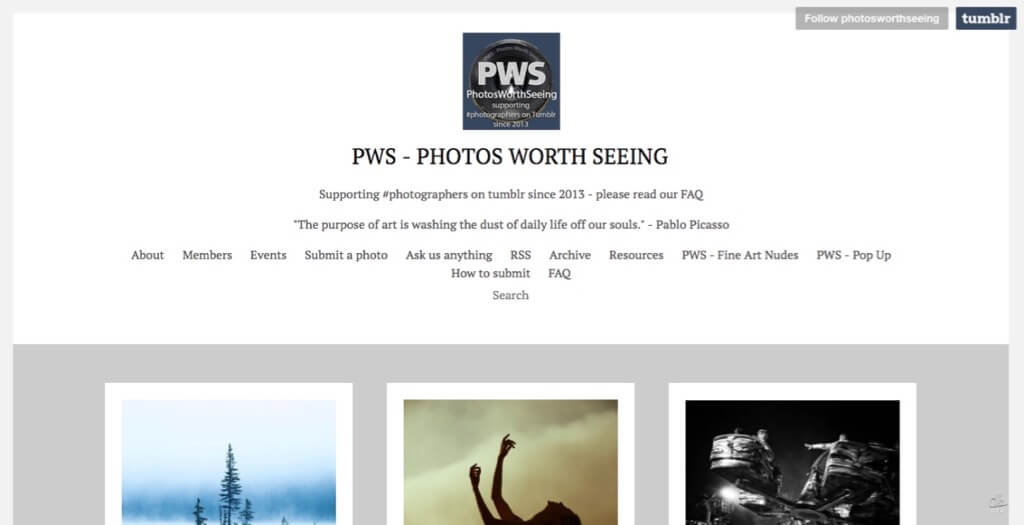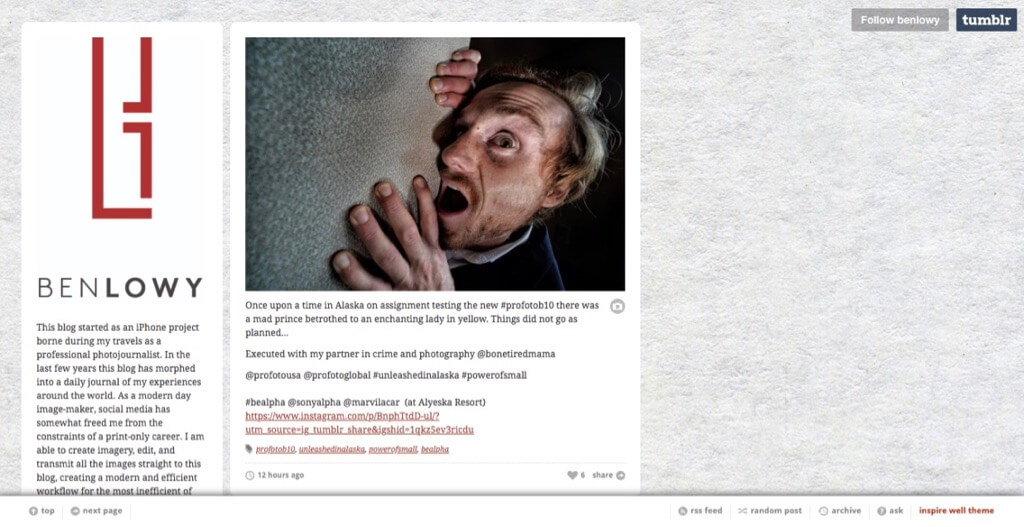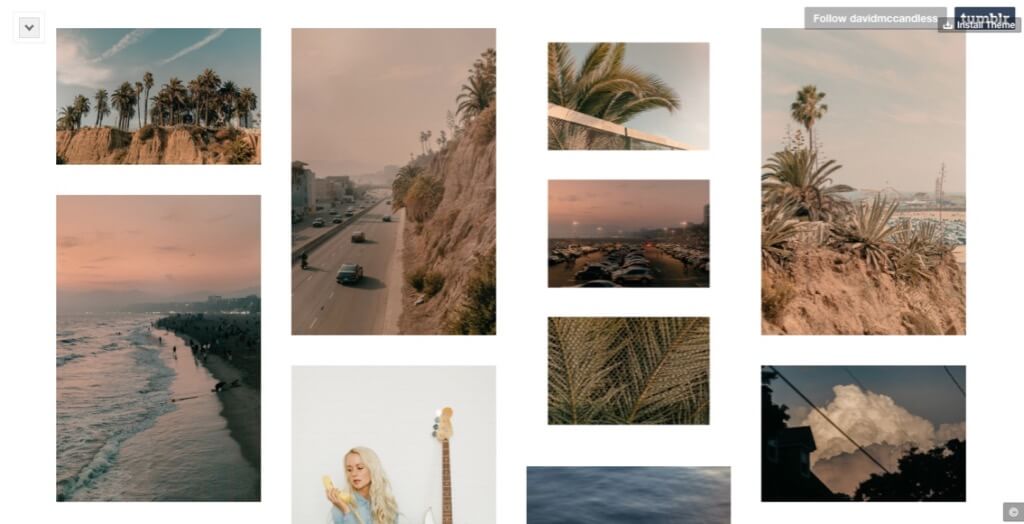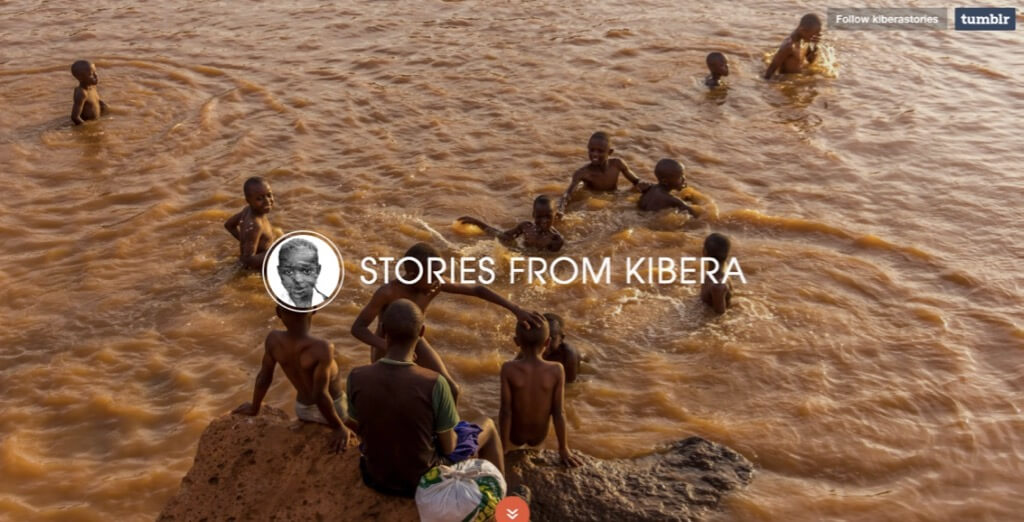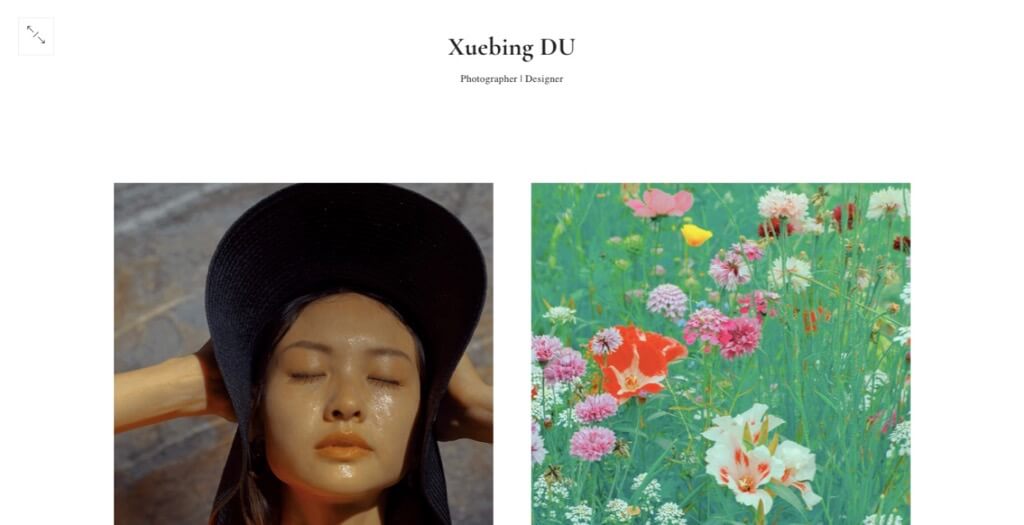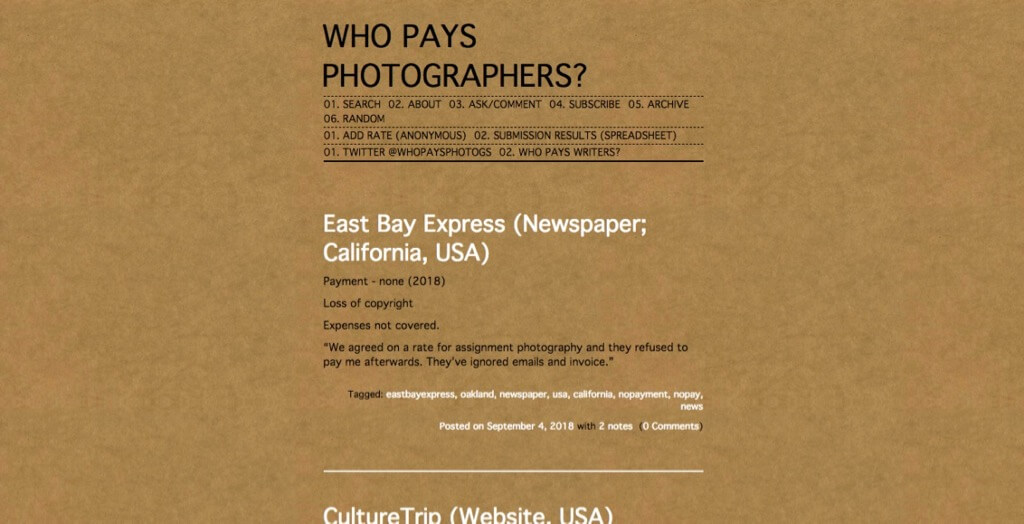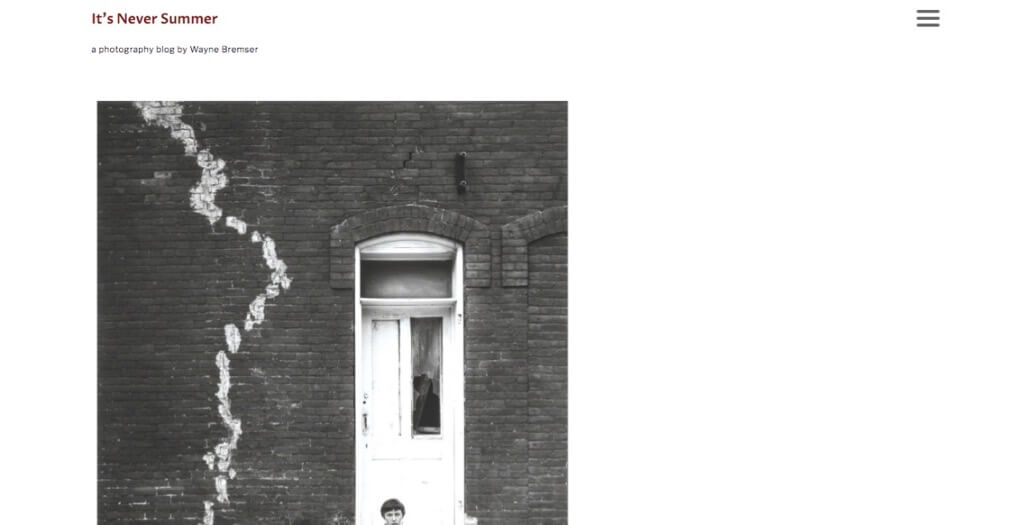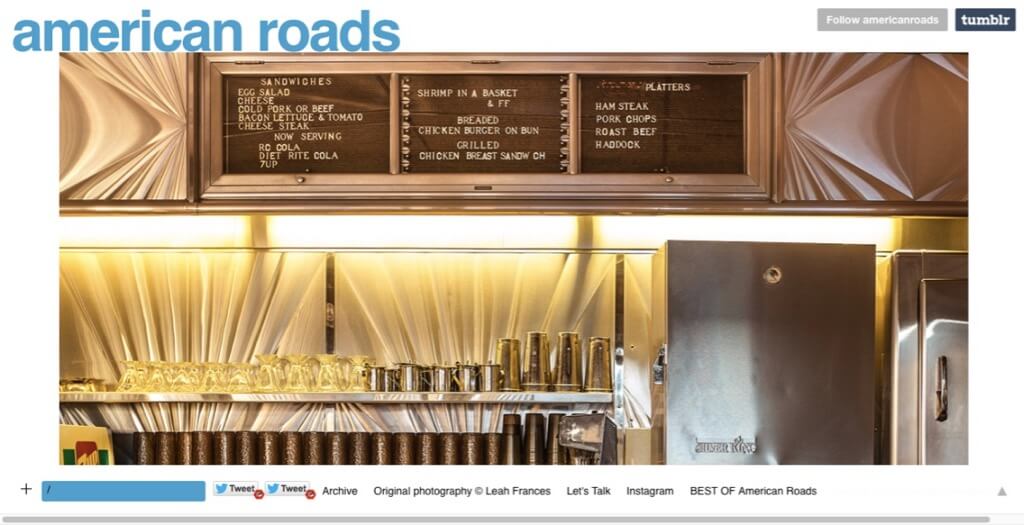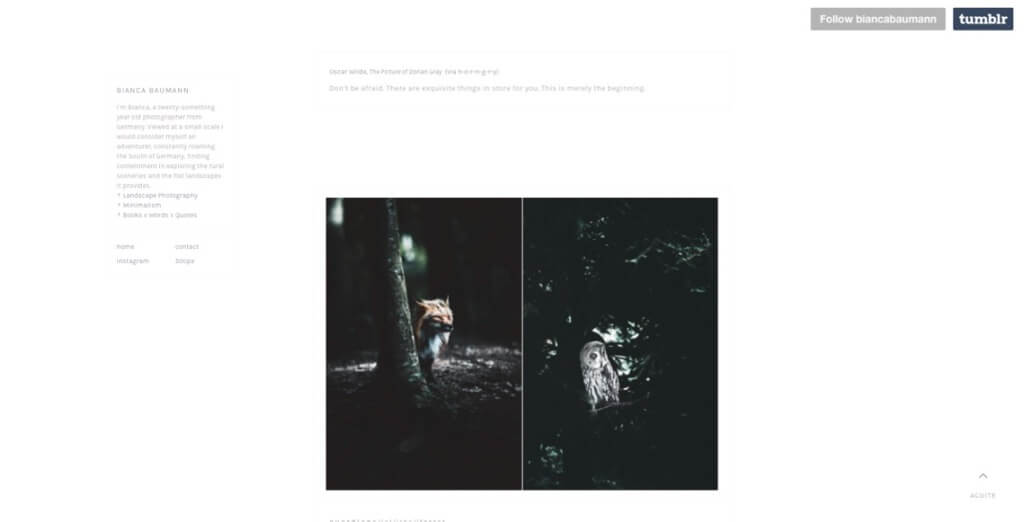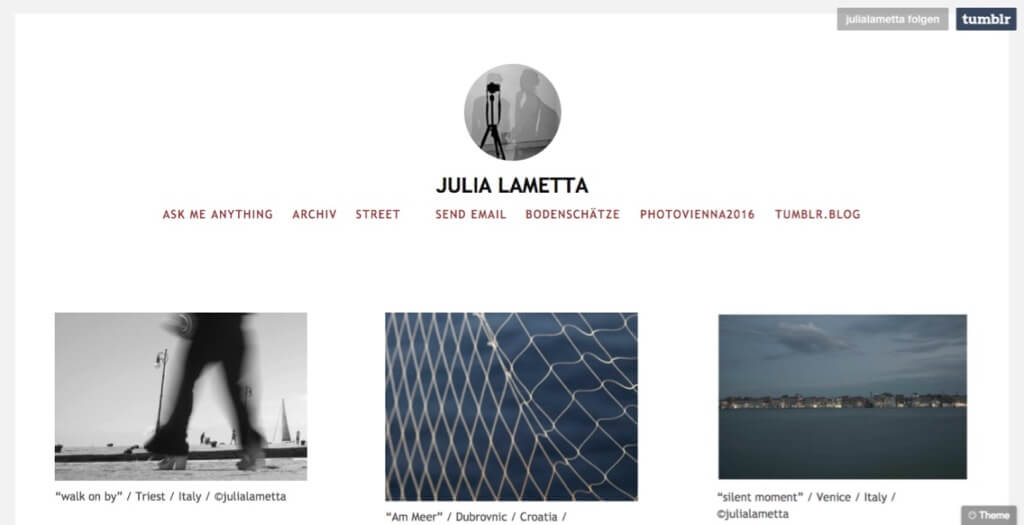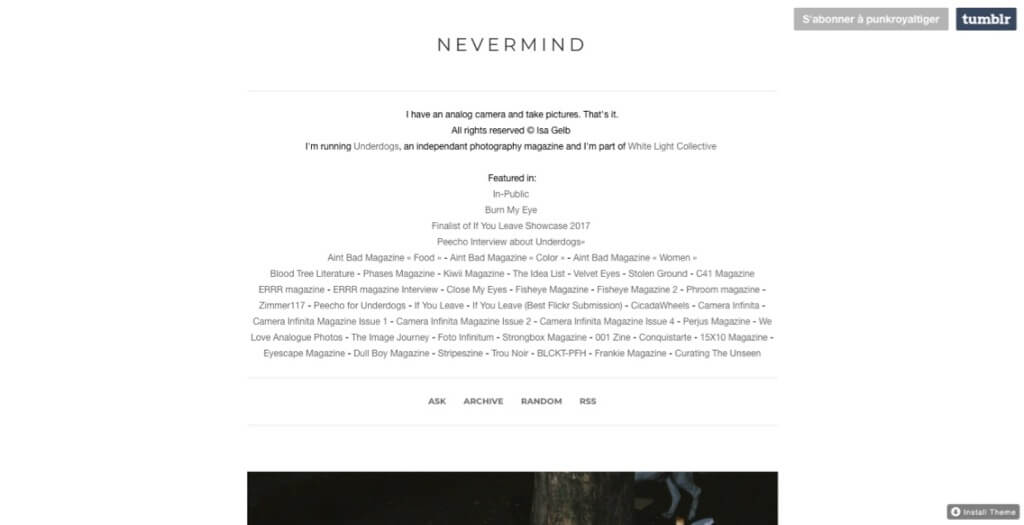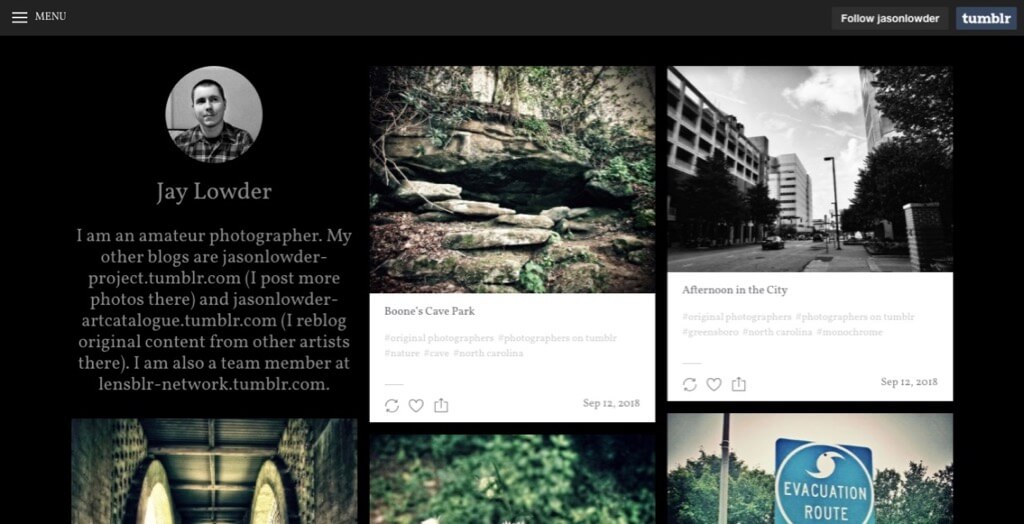Founded back in 2007, Tumblr is now one of the largest social networks in the world. It used to be the top site for microblogging, but since Instagram has exploded in popularity, Tumblr is no longer the hive of activity it used to be.
Nevertheless, Tumblr is still a great site for sharing photos and finding inspiration. Its vibe has changed since Instagram became a competitor, but that change might be a good thing, depending on what type of photographer you are.
If you’re a professional photographer or want to become one, Instagram is typically regarded as the “better” platform to use, since it’s more popular. This popularity can mean more engagement and contact with clients. If used strategically, Instagram can really further your career.
However, if you want more creativity, you might like Tumblr better. Although it’s less popular, it tends to have more avant-garde photos, experimental ideas, and creative designs.
This difference might be rooted in the way each platform works. Instagram is designed to be fast and simple. The layout and filters are pretty much the same for each user, and the workflow is easy to learn.
Tumblr, on the other hand, is slightly more complex. It allows for more customization and creativity. You can design the appearance of your page, so your photos are presented in a way that matches your style.
In other words, if you want to explore new ideas and build a blog, try Tumblr. If you’re looking for thousands of “likes” and followers, choose Instagram. If you want both — a large audience and creative freedom — consider signing up for both.
To give you a feel for the crowd on Tumblr, here are 20 creative blogs from curators, professional photographers, and amateur photographers on Tumblr. For a taste of Instagram, check out these 25 inspirational portrait photographers to follow on Instagram.
Curators
Curation is very common on Tumblr, thanks to the site’s “reblog” feature. Reblogs on Tumblr are like retweets on Twitter; they allow users to share images without claiming credit for those images. Instead, the original source is given. This way, photos (and the photographer’s fame) can spread more easily.
Curators are users who don’t create original content, but rather feature images from a variety of photographers, either by reblogging or by posting the photos with the photographer’s permission. Some curators are exclusively on Tumblr, while others are also on Instagram and other social media. Here are some great curators worth looking at.
Dear Photograph
This blog started as a spontaneous series of photos, taken during a family get-together. The family was looking through a photo album when the creator of the blog, Taylor Jones, noticed that his brother was sitting in the exact same spot as in one of the photos. He got his camera, held up the old photo, and snapped a picture.
He took six other pictures, all with the same concept: an old photo, lined up against its original location. He posted them on the blog, and they went viral. He started receiving photos taken in the same way, the best of which he posted. The name Dear Photograph was born, along with the motto: “Take a picture of a picture from the past in the present.”
Eight months later, the blog had millions of hits and had been named one of the best sites of the year by Time magazine. The blog is still going strong, too, though it’s no longer just a blog. It’s also on Twitter, Instagram, and Facebook. There’s even a Dear Photograph book, full of nostalgic photos and stories.
Staged Photography
Staged Photography celebrates photos that were made deliberately, focusing on craft rather than coincidence. The blog features images that were carefully created, where the photographers had complete control over the environment, emotion, and composition.
“The staged and constructed image is so much more compelling than a serendipitous one,” the blog argues. “There are many shooters who have a good eye. They can take a mundane moment and capture it in a powerful way… But an image that was created, that had its elements consciously placed and its composition arranged… That’s painting with light.”
Original Photographers
Visit the Original Photographers blog, and your screen will be immediately filled with gorgeous images. The grid layout and lack of text make beautiful photography the heart of the blog, though you can also click through to see each photo’s title and credit, as well as a link to the photographer’s site.
Established by a photographer, Fay Freshwater, the blog’s main goal is “to promote, support and encourage hard-working photographers.” Anyone can submit photos to the blog, so if you’ve got an image you’re proud of and want to expand your audience, this could be one way to do that!
The Photographers Directory
The Photographers Directory is another blog that showcases photographers in order to connect them with a larger audience. “Our most important goal is to get your work exposed to as many viewers as possible, and to make it easier for them to find you.”
Like Original Photographers, The Photographers Directory works off of submissions, ideally from regular bloggers on Tumblr. Their overall aesthetic or approach is slightly different though. Rather than presenting all the photos in a grid, The Photographer Directory showcases one photo at a time, so you automatically see each photographer’s notes and details.
Lensblr
Lensblr is one of the most popular photo curators on Tumblr. Run by a team of volunteers, the blog “is an advocate for the original photographers on Tumblr — the creators in the Tumblr world.
Our goal is two-fold: first, to bring more attention to the creative works of these content creators on Tumblr. And second, to build community among fellow photographers on Tumblr and the people who enjoy their work.”
Lensblr works off of submissions but also reblogs. They prefer to reblog because it allows the original photographer to receive all the comments, notes, and notifications about the featured photo. This approach means that there are fewer details about each photo on Lensblr, but you can easily click through to see the photographer’s blog.
Another | Place
Like Staged Photography, Another | Place focuses on projects or series rather than single photos. The blog showcases “contemporary photography which explores the landscape in the widest sense, covering themes which include land, place, journey, city, and environment.” Each series includes a description and, occasionally, an interview with the photographer.
The blog is run by a photographer, Iain Sarjeant, who’s also established a small independent publisher by the same name: another | place. Photos from the blog are on Instagram, too, albeit with fewer details. For the full scoop, you have to go on Tumblr.
PWS – Photos Worth Seeing
PWS is very similar to Lensblr. It’s run by a team who reblogs and reviews photos from photographers on Tumblr. Started in 2013, the blog has been so popular that they’ve started a couple sister blogs: PWS – Fine Art Nudes and PWS – Pop Up.
PWS also has regular “photography specials,” where they pick a theme and then post submitted photos around that theme. These extras give the blog a community feel in addition to the lovely photography.
Professional Photographers
Although Instagram is typically the professionals’ first choice, some full-time photographers use Tumblr to explore new concepts or further expand their audience. The following professional photographers use Tumblr in many different ways, so you can get a good idea of what’s possible.
Ben Lowy
Benjamin Lowry is an award-winning photographer who started his career in 2003 by covering the Iraq War. He’s since been on assignments worldwide in a variety of genres: journalism, editorials, sports, commercials, etc. His Tumblr blog began as an iPhone project, which he created when he was traveling as a photojournalist. Now, it’s a journal of his experiences around the world.
“Social media has somewhat freed me from the constraints of a print-only career,” he says. “I am able to create imagery, edit, and transmit all the images straight to this blog, creating a modern and efficient workflow for the most inefficient of pursuits – self-expression.” You can also follow him on Instagram and Vimeo.
David McCandless
David McCandless is a wedding photographer who uses his Tumblr blog for landscapes, portraits, and experimental images. He’s completely separated the two sides of his photography. His professional wedding and engagement photos are on his website and Instagram, while his “personal” photos are on Tumblr.
Interestingly, he hasn’t linked his Tumblr blog to his website/Instagram or vice versa. His followers on Tumblr won’t necessarily find his website, while clients that discover him via Instagram or his website won’t necessarily find his blog. While this separation might limit his business reach, it does allow him creative freedom outside of his wedding/engagement photography brand.
Stories from Kibera
Brian Otieno, also known as Bryan Jaybee, is a photojournalist who was raised in Kibera, “Africa’s most vibrant, biggest shantytown in Nairobi, Kenya.” His blog, Stories from Kibera, is a long-term project that focuses on “telling the everyday stories from Kibera.”
The blog offers a unique perspective of Kibera because Brian is both an insider and, as a photographer, an outside observer. Many of his photos are of the people in the community, capturing their stories, dreams, and potential. Besides Tumblr, you can now follow the project on Instagram, Behance, and a few other major platforms.
Stephanie Gonot
Stephanie Gonot is a quirky, Los Angeles-based photographer whose clients range from Amazon and Adidas to WIRED and The New Yorker. Her blog is a great example of how photographers can connect their Tumblr blogs to their website, creating a distinct style that’s reflected on both.
Her colorful website and blog are blended so seamlessly that it’s natural for visitors to go between the two. Anyone who finds her work via Tumblr can easily visit her site, perhaps without realizing it. This approach is ideal if you want to use social media to increase your site’s traffic.
Demas Rusli
Demas Rusli is an architect and photographer based in Sydney, Australia, who’s worked with big brands such as Adobe, Nike, and Samsung. He specializes in urban, landscape, aerial, and architecture photography, a perfect match with his background as an architect.
Typically, Demas uses Instagram to share photos on Tumblr. Connecting the two accounts is easy, so many photographers use this strategy to efficiently expand their audience. However, sharing photos on Tumblr via Instagram is noticeable and can affect a photographer’s impact on Tumblr.
Just compare Demas’s following on each platform; he gets thousands of likes for each photo on Instagram, while the same photos might only get a few notes on Tumblr. Still, if you want to maximize your reach without spending much time on social media, this method can be worth pursuing.
Xuebing Du
Xuebing Du is a designer and photographer based in Cupertino, California, whose work revolves around nature, color, and texture. Her style is reminiscent of historical paintings with romantic florals and plants. “I want to capture characters in florals, the gentleness, softness and oftentimes its toughness,” she says. “I photograph plants that appear soft and gentle, but still have a powerful image.
Unlike Demas, Xuebing has given more attention to Tumblr than Instagram, and you can see that difference in her Tumblr notes. She gets several hundred notes for every photo, more than her Instagram likes. Then again, her artistic style might also “fit” the Tumblr crowd more than Instagram.
Who Pays Photographers?
This blog doesn’t belong to a single professional photographer, but rather to all professionals. It deals with a subject that affects all photographers who are trying to earn a living: how much or little they get paid by clients. Any photographer can anonymously submit details about a job they did (editorial, commercial, etc.) and how much they were compensated.
“This is intended as an exercise in sharing, rather than shaming – but feel free to warn your fellow photogs about deadbeats” the blog states. “No doubt, there will be conflicting reports. Outlets play favorites and situations vary. Still, the more data points, the fuller the picture for everyone.” Who Pays Photographers? is a useful reference for any photographer interested in going freelance.
Amateur Photographers
Many hobby photographers use Tumblr like a photo diary. Despite the label “amateur,” the photographers below show a lot of talent and interesting ideas. Some may even be on the brink of going full-time, partly thanks to the support they’ve found through social media.
Wayne Bremser
Wayne Bremser’s Tumblr blog isn’t just a collection of photos; it’s also a journal for his thoughts on photography and art. On the landing page, you see photos that have inspired him, along with attribution and links to the original sources. To see additional notes, thoughts, and a few interviews, click on the menu.
Altogether, the blog offers “a combination of criticism, commentary, and research about photography and communication with images.” If you connect with his ideas, you can check out his Instagram, too. Though it’s not as deep as his blog, it’ll show you the inspiration being put into practice.
American Roads
Leah Frances has worked as a graphic designer, art director, photo editor, and production editor, and those jobs have led her to pick up photography, once a passion of hers. She started her blog on Tumblr when she first started shooting again and traveling through the US. She used it both as a travel diary and for feedback, documenting “random thoughts, road trips, vintage stuff, Americana, typography, architecture, interiors, and a dash of Brooklyn, New York.”
Later, she got on Instagram, where she now has a huge following. Nevertheless, she keeps up her original Tumblr blog, the place where she first “practiced” her photography and found a supportive community.
Bianca Baumann
Bianca Bauman from Stuttgart, Germany, considers herself an adventurer who’s “constantly roaming the South of Germany,” exploring its rural sceneries and flat landscapes. She posts her photos on both Tumblr and Instagram, though her Tumblr blog is richer in personality. Besides her photos, she uses her blog to post quotes, mainly from books or about books. If you’re a literature fan, this combination of photographs and literary quotes might be exactly what you’re looking for.
Julia Lametta
Julia Lametta is based in Venice, Italy, but her photos are from all over. She mostly focuses on street/urban photography and tends to create images that are conceptual, abstract, or otherwise “artful,” from reflections in puddles to blurred pedestrians walking.
Isa Gelb
“I have an analog camera and take pictures. That’s it.” That’s the description of Isa Gelb’s blog, and it’s a good summary of what you’ll find: analog photos of random things she’s noticed. Her work has been featured in a bunch of independent magazines, and she runs her own independent photography magazine, too, called Underdogs. You can also follow her on Instagram.
Jay Lowder vs. The Jay Lowder Project vs. Jason Lowder Artcatalogue
Jason Lowder has three Tumblr blogs. One is for his “normal” photography, one is for his “alternative edits, experiments and other random things,” and one is for his inspiration, where he reblogs content from other artists. He’s also a team member at Lensblr.
Clearly, he’s a fan of Tumblr, and it’s easy to see why. He’s been able to build a great community on the site, from which he continues to receive valuable feedback and encouragement. Though Instagram is more popular, sticking with Tumblr is natural for photographers like Jason. In the end, you go where your community is.

